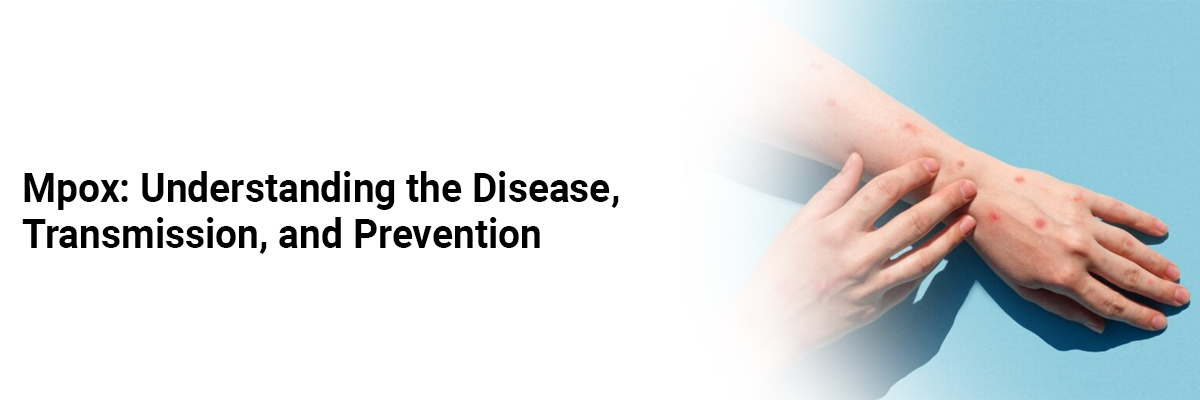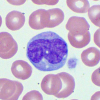
 Mrs. Mayuri Mathur
Mrs. Mayuri Mathur
Mpox: Understanding the Disease, Transmission, and Prevention
Mpox, previously known as monkeypox, has been a public health issue in certain regions of Africa since 1970. However, it gained significant global attention in 2022, when a surge in cases worldwide led the World Health Organization to declare a global health emergency. Mpox typically causes flu-like symptoms and pus-filled lesions and can lead to severe clinical outcomes.
Mpox (monkeypox) is a zoonotic orthopoxvirus that can cause
disease in humans, similar to smallpox. It is a rare virus that typically
infects rodents, like rats or mice, and nonhuman primates, like monkeys, and
spreads from animals to humans. There are two types of mpox virus: clade I and
clade II.
- Clade I causes more severe illness and has
a higher mortality rate. Some outbreaks have resulted in death rates of up
to 10%, although more recent outbreaks have seen lower death rates. Clade
I is endemic to Central Africa.
- Clade II is responsible for the global
outbreak that began in 2022. Infections from clade II mpox tend to be less
severe, with a survival rate of over 99.9%. This clade is endemic to West
Africa.
Certain groups are at higher risk of developing severe illness,
including:
- Individuals with severely compromised immune systems
- Children under the age of 1
- Those with a history of eczema
- Pregnant individuals
Transmission of Mpox
Mpox spreads through direct contact with the blood, bodily
fluids, or skin lesions of infected animals or humans. It can also be
transmitted via respiratory droplets during prolonged face-to-face contact,
though this mode is less common than smallpox. Human-to-human transmission can
occur, especially among close contacts such as family members or healthcare
workers. Infected individuals can spread the virus from the onset of symptoms
until all lesions have crusted over and new skin has formed.
The virus can also survive on surfaces and materials, such as
bedding and clothing, used by an infected person, leading to indirect
transmission. In areas where the disease is endemic, people can become infected
by handling infected animals or consuming undercooked meat from these animals.
Symptoms and Clinical Complications
Mpox symptoms may start 3 to 17 days after the exposure and may
last 2 to 4 weeks. The symptoms of mpox are similar to but milder than, those
of smallpox, which include:
- Fever: A sudden onset of fever is one of
the first symptoms.
- Headache: Severe headaches often accompany
the fever.
- Muscle Aches and Backache: These are common and
can be quite debilitating.
- Swollen Lymph Nodes: This is a
distinguishing feature from smallpox, as lymphadenopathy (swelling of
lymph nodes) is more pronounced in mpox.
- Fatigue: A general feeling of tiredness
and weakness.
Within a few days of the onset of fever, a rash develops, often
starting on the face and then spreading to other body parts, including the
palms of the hands and soles of the feet. The rash progresses through several
stages—from macules to papules, vesicles, pustules, and finally to scabs—before
healing.
Although it is rare, mpox can sometimes be fatal. The disease can also cause complications, such as pneumonia and infections in the brain (encephalitis) or eyes, which can be life-threatening.
Diagnosis
Since mpox is uncommon, it may be initially suspected as other
rash-related illnesses, such as measles or chickenpox. However, swollen lymph
nodes typically differentiate mpox from other similar conditions. To diagnose
mpox, a healthcare provider will take a tissue sample from an open sore
(lesion) and send it to a laboratory for polymerase chain reaction (PCR)
testing, which involves genetic fingerprinting. In the absence of skin lesions,
testing can be done using swabs or the throat or anus. Additionally, you
might be asked to provide a blood sample to detect the presence of the mpox
virus or antibodies produced by your immune system.
Prevention and Treatment
There is currently no specific treatment for mpox, but the disease is self-limiting and resolves on its own without the need for treatment. Supportive care, such as hydration, pain management, and treatment of secondary bacterial infections, can help alleviate symptoms and prevent complications.
Prevention is the best approach to controlling mpox. Key
preventive measures include:
- Vaccination: The smallpox vaccine
has been shown to provide cross-protection against mpox. In some
countries, the smallpox vaccine is used to protect those at high risk,
such as healthcare workers or close contacts of confirmed cases.
- Avoiding Contact with Infected Animals: In endemic regions,
people should avoid handling animals that may carry the virus, such as
rodents and primates.
- Practicing Good Hygiene: Regular hand washing
with soap and water, using hand sanitizers, and avoiding contact with
potentially contaminated surfaces can reduce the risk of infection.
- Using Personal Protective Equipment (PPE): Healthcare workers
caring for patients with suspected or confirmed mpox should use
appropriate PPE to prevent exposure to the virus.
How to Take Care of Yourself If You Have mpox
If you experience mpox symptoms, there are several
over-the-counter (OTC) medications and self-care measures that can help
alleviate discomfort:
- If you are infected, isolate yourself from others until
all lesions have formed scabs to prevent the virus from spreading.
- Medications such as ibuprofen and acetaminophen can
help ease pain and reduce fever.
- Taking a warm bath with colloidal oatmeal can help
soothe dry, itchy skin associated with rashes.
- Use gauze or bandages to cover individual or localized
sores to reduce the risk of spreading the infection to others and the
environment.
- Stay home and rest, wear a mask around others to limit
transmission, and drink plenty of fluids to stay hydrated.
- To prevent spreading the virus to animals, refrain from
interacting with pets while you are infected.
- Avoid popping blisters or scratching sores, as this can
delay healing, spread the rash to other parts of your body, and increase
the risk of infection.
- Refrain from shaving areas with sores until scabs have
healed and new skin has formed underneath, as shaving can cause the rash
to spread to other areas.
References:
- Centers for Disease Control and Prevention. Mpox. 2023.
Available from: https://www.cdc.gov/poxvirus/mpox/index.html
- World Health Organization. Mpox [Internet]. 2023.
Available from: https://www.who.int/news-room/fact-sheets/detail/mpox
- Cleveland Clinic. Monkeypox: What You Need to Know
[Internet]. 2023. Available from: https://my.clevelandclinic.org/health/diseases/22371-monkeypox
- Centers for Disease Control and Prevention. About Mpox
[Internet]. 2023. Available from: https://www.cdc.gov/poxvirus/mpox/about/index.html
- Mayo Clinic. Monkeypox FAQ [Internet]. 2023. Available
from: https://www.mayoclinic.org/diseases-conditions/infectious-diseases/expert-answers/monkeypox-faq/faq-20533608
- NDTV. New Mpox Strain Mutating Very Rapidly: How
Scientists Are Responding [Internet]. 2023. Available from: https://www.ndtv.com/world-news/new-mpox-strain-mutating-very-rapidly-how-scientists-are-responding-6426881
- McCollum AM, Damon IK. Human Monkeypox. In: Feigin and
Cherry’s Textbook of Pediatric Infectious Diseases. 8th ed. Elsevier;
2019. Available from: https://www.ncbi.nlm.nih.gov/books/NBK574519/

Mrs. Mayuri Mathur
Mrs. Mayuri Mathur is a Senior Medical Writer (Patient education and digital) and seasoned content creator with a rich tapestry of expertise spanning over ten years. With a diverse background in content creation, she brings a wealth of experience to the table, from crafting insightful medical articles to developing comprehensive patient education materials, dynamic press releases, and captivating brochures and website content. Throughout her illustrious career, she has demonstrated an exceptional knack for distilling complex medical concepts into easily understandable content, making her a trusted resource for both professionals and lay audiences alike. Her meticulous attention to detail and innate creativity have enabled her to deliver content that not only informs but also engages and inspires. Whether elucidating intricate medical procedures or crafting compelling marketing materials, her versatility and dedication shine through in every project she undertakes. Her passion for writing, coupled with her profound understanding, makes her an invaluable asset to any team or project. In a constantly evolving digital landscape, where effective communication is paramount, Mrs. Mayuri Mathur stands out as a beacon of excellence, consistently delivering top-notch content that resonates with audiences across diverse platforms.

.png)

.png)
.png)

.jpg)










Please login to comment on this article